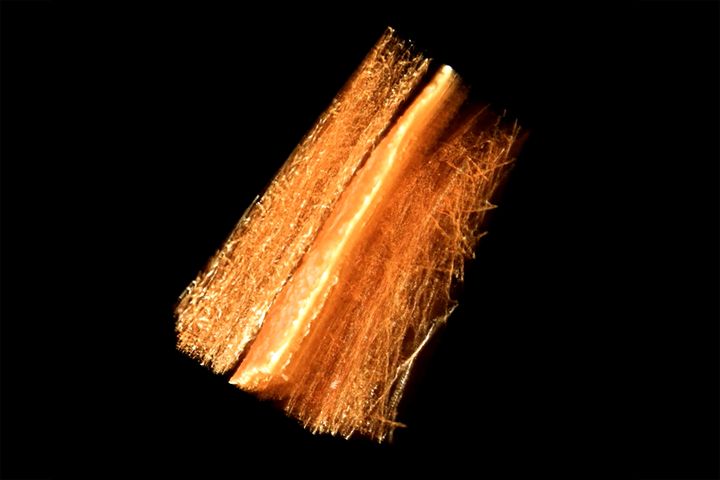
This 3D image taken at Los Alamos National Laboratory by x-ray tomography shows an experimental fuel cell membrane electrode assembly.
By Rod Borup
Fuel cells have long been one of the most tantalizing clean-energy solutions. They offer electricity from an abundant energy carrier — hydrogen. Their energy density and scalability allow them to power everything from cell phones to cars, homes to the electric grid itself. They are more than twice as efficient at converting fuel to power than internal combustion engines. They use hydrogen that can be produced by using renewable energy such as solar or wind power to split water — H2O —into hydrogen and oxygen. And since the only byproducts of fuel cells are water and heat, they do all this without spewing climate-warming carbon dioxide.
Yet for decades commercially viable fuel cells, particularly for cars, have remained just over the horizon. So why aren’t we there yet? After all, fuel cells kept the lights on for the astronauts in the Apollo spacecraft nearly 50 years ago.
Despite that legacy, two tightly interrelated factors have kept mass-produced hydrogen-powered cars out of the auto showrooms: cost and durability. Fuel cell vehicles are now in an early commercialization stage and available for purchase, however the cost is out of the reach of most consumers. For mass commercialization, fuel cell vehicles need to be on cost-parity with those with traditional internal combustion engines.
This is largely because of the expensive platinum and related metals used in most fuel cells; adding catalyst increases durability but also ratchets up the cost. That’s a deal-breaker for most mainstream car buyers. They demand that hydrogen cars at least match the price and reliability of conventional cars, but the few hydrogen-powered models on the market today cost significantly more than comparable internal-combustion-powered cars or even hybrids.
Now here’s the good news: All that may change in a few years. To make fuel cells competitive, a U.S. Department of Energy-funded, science-based approach is driving efforts to better understand the materials in them. As part of this initiative, Los Alamos National Laboratory is leading two efforts with industry partners, academics and other national laboratories to lower fuel-cell cost by developing less expensive materials while maintaining durability. The work is being carried out under two consortia within DOE’s Fuel Cell Technologies Office in the Office of Energy Efficiency and Renewable Energy.
In the Fuel Cell Consortium for Performance and Durability, led by Los Alamos, laboratory researchers are working with Argonne National Laboratory, Lawrence Berkeley National Laboratory, the National Renewable Energy Laboratory, Oak Ridge National Laboratory, General Motors, 3M, UTRC and Vanderbilt University on specific projects related to commercializing low-platinum fuel cells.
In the Electrocatalysis Consortium, Los Alamos and Argonne National Laboratory, along with the National Renewable Energy Laboratory and Oak Ridge National Laboratory, are studying materials for platinum-free catalysts in automotive fuel cells.
This work is a natural for Los Alamos. Our deep familiarity with hydrogen as part of its nuclear security mission, our researchers have been studying fuel cells and sharing the research with industry since the 1970s. In fact, the Laboratory’s early demonstrations helped jump-start the fuel-cell-powered transportation industry.
A typical fuel cell today consists of a pair of flow-field plates, a pair of electrodes and a pair of platinum catalysts, all sandwiching a polymer membrane, a material much like Saran wrap, in the middle. Pressurized hydrogen fuel enters the system on one side, oxygen (from air) on the other.
As the hydrogen passes through the catalyst, an electrochemical reaction strips off their electrons, pushing electric current through an external circuit to the electrode on the oxygen side. Meanwhile, positively charged hydrogen — protons — pass through the membrane to the oxygen side. There, in the second half of the electrochemical reaction, a catalyst uses the electric current to add electrons to the oxygen and protons. That reaction forms water and releases heat. The electric current in the external circuit can power a car or anything else using electricity.
The research focuses on better understanding the science behind catalysts to advance performance and durability and to develop the knowledge base and optimize structures for more durable and high-performance components. For instance, GM and Los Alamos are studying the effect of operating conditions on fuel-cell performance and membrane failure. We’ve made breakthroughs in preventing platinum-free catalysts from disintegrating in the acidic conditions of fuel cells. Additional work will probe the properties and performance of these materials.
The catalyst material—again, usually platinum—is the crux of the cost problem. To solve it, we’re working within the ElectroCat consortium to investigate less expensive, more abundant materials based on carbon compounds. The goal of our work with automakers and other developers is simple: Reduce the cost of ownership of a fuel-cell powered car so this clean power can compete in the marketplace with no inconvenience to the customer. The DOE consortia and innovative research at the laboratory are key to making this happen. Then we can all enjoy the benefits of clean air and reduced carbon-dioxide emissions, which will help counteract global climate change without sacrificing the mobility and convenience we enjoy today.
Rod Borup is the program manager of the fuel cells group at Los Alamos National Laboratory and has made extensive contributions to the fuel cell research community as a renowned expert since coming to the Laboratory in 1994. He is the director of FC-PAD, a member of the U.S. DRIVE Fuel Cell Technical Team, and co-chair of the DOE’s Fuel Cell Technologies Office Durability Working Group. Explore the long history of fuel-cell research along with recent breakthroughs at the Fuel Cells website.
